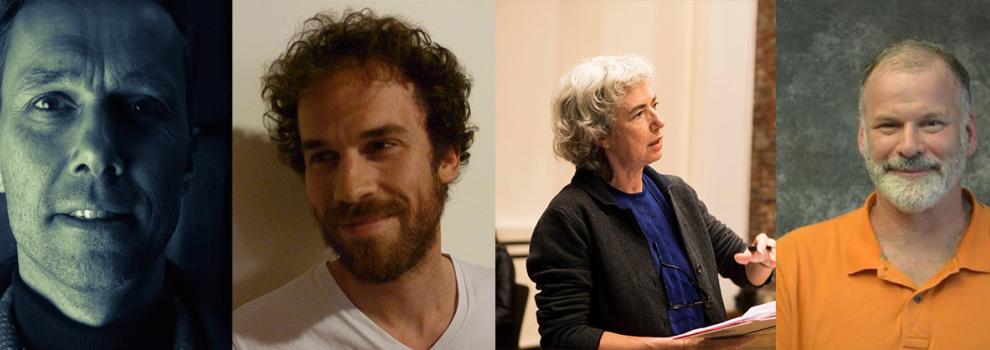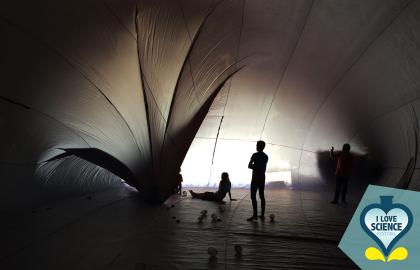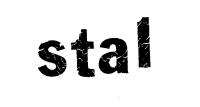
‘TALKS: COPING WITH COMPLEXITY - sold out’
Past event
Cancelled
Postponed
27 Apr.'18
- 15:00
When Art Meets Science
Scientific and artistic ways to order chaos
Are mathematics, statistics and data hoarding the ultimate ways to organise what seem to be random phenomena? Maybe, maybe not. Since the arts introduce other dimensions of ordering seemingly random phenomena, and chaos.
This Crosstalks meeting explores scientific and artistic ways of coping with complexity: from brain-blowing science to visual arts and music.
15:00 Introduction by Jean Paul Van Bendegem (VUB-Philosopher/Mathematician)
15:05 Marleen Wynants (Director VUB Crosstalks): The first computers were women
15:30 Lawrence Malstaf (artist, the EXHALE installation and performance goes public on April 28, 2018): The anti-automaton
Presentation of aspects of his practice as an installation artist, dealing with animated objects, anti-automatons and coincidence. The work of Lawrence Malstaf is at the crossroads between the visual and the theatrical. He develops installation and performance art with a strong focus on movement, coincidence, order and chaos, and immersive sensorial rooms for individual visitors. He also creates larger mobile environments dealing with space and orientation, often using the visitor as a co-actor. His projects involve physics and technology as a point of departure or inspiration and as a means for activating installations. Malstaf is also known as an innovative scenographer in the world of theatre and dance.
15:50 Michel Tombroff (ULB, University of California Santa Barbara): Tautological Limitations in Conceptual Art: A Proposal to Represent the Beauty of Truth
We present a critique of the analytical tradition of conceptual art, and more specifically the tautological drift that caused conceptual art to distance itself from the minimal and essential aesthetic conditions required for a democratic experience of the work of art. We then propose to use mathematics, in particular the theory of infinite sets as invented by Georg Cantor and elevated to the status of ontology by Alain Badiou, as an aesthetic foundation to conceptual art in order to free it from these tautological limitations and reassert its aesthetic ambition. Finally, we present some recent works aimed at empirically testing the validity of this theory.
16:10 André Ariew (University of Missouri): Abstract statistical ideas made simple: The case of Francis Galton’s quincunx
Sometimes daunting and abstract statistical ideas can be presented simply. I will demonstrate this with an important episode in the history of biology. Francis Galton used a toy machine that he constructed, called a "quincunx", to explain the phenomenon of reversion. With the quincunx Galton showed that reversion is a purely statistical rather than—as Charles Darwin believed—a biological phenomenon. Galton's presentation, though simple, would have profound implications for the development of evolutionary biology and statistics.
16:40 Q&A + Break
17:00 Isar Goyvaerts (VUB): Symmetry in music: A means of exploring the modern Western classical repertoire
To many people, a considerable amount of 20th and 21st century Western classical music sounds "chaotic" when you first listen to it. Compared to compositions from other eras, such music sounds rather strange to our ears and we rarely feel encouraged to give it a second listen. In this talk, we discuss two short pieces by two composers and investigate whether some insight into certain mathematical concepts may be a means of exploring (part of) the modern repertoire. No background in music theory or mathematics is required for this lecture.
17:30 Bruno Letort (Ars Musica): Le Pavillion Philips : Fusion des Arts ?
At the request of Philips, Le Corbusier suggested creating an electronic poem for the 1958 Brussels World’s Fair. It’s a collage of screenings and colourful atmospheres, which provides an eight minute overview of the modern world, accompanied by Edgar Varèse’s “concrete” music. Iannis Xenakis was entrusted with its design and made the most of this opportunity by covering the pavilion in thin-shelled concrete. The work itself is housed in a big black space. For the three creators (Varèse, Le Corbusier and Xenakis) this pavilion was the opportunity to experiment with the most avant-garde things that were going on in the field of artistic production technologies.
18:00 Open discussion
18:30 Festival cocktail
Practical information
Dates
Location
Bertouille Rotunda
Rue Ravenstein 23 1000 BrusselsLanguage
- English
DATE
Fri 27 Apr 2018 15:00-19:30
LOCATION
Rotonde Bertouille
Co-production
Collaboration
In the framework of



